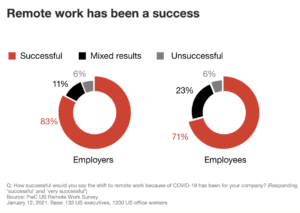Although the pandemic has accelerated the advent of remote work, the shift to dispersed workforces has been several years in the making. For instance, data from the US Bureau of Labor Statistics shows that the number of Americans working remotely increased by 115% between 2005 and 2015. Meanwhile, the ONS reports that 27% of the UK workforce (approximately 4 million people) in 2019 already worked from home, at least some of the time.
Of course, COVID-19 brought the importance and value of remote working to sharp relief. At the height of lockdowns, it’s estimated that 60% of UK adults were working from home.
Source: Finder
But like many other sweeping changes in the workplace, the shift to remote working is likely to stick around for good.
Hybrid and remote working are here to stay
According to Gallup, three in five Americans who worked from home during the pandemic want to continue working remotely after restrictions are lifted. Meanwhile, our employee census in 2021 found that 64% of US and UK workers want permanent hybrid working — a mix of in-office and remote working arrangements.
Related Reading: The Hybrid Workplace: An Employee Census
These studies highlight that workers clearly want more flexibility in their work. And why wouldn’t they? Report after report shows that working from home results in better work-life balance and makes people more productive than working in a traditional office.
However, despite the chorus of workers demanding a permanent shift to hybrid and remote working, many employers are still adamant about returning to the office. Research by the CIPD, the professional body for HR and people development in the UK, suggests that employers are split on whether hybrid working — and other types of flexible working, for that matter — will last. Nearly half of senior decision-makers (42%) feel that “the memory of the pandemic will fade quite quickly, and it won’t be long before we revert to the way we worked before COVID-19.” However, 41% disagreed with that statement.
There’s a similar split happening among American employers. In the US financial services sector, for example, banks like Citigroup and UBS have allowed workers to work either 100% or part of the time remotely. But other institutions like Goldman Sachs, Bank of America and Morgan Stanley are taking a hardline approach, requiring employees to come to the office five days a week.
If you’re one of the many organisations that have shifted to remote or hybrid working, your employees may also expect your changes to be permanent. But as you may have already found out, managing a remote workforce comes with its share of challenges — chief among them maintaining consistent levels of productivity. We’ve put together a brief guide to address this issue and help you set up your staff for success.
Related Reading: The Future of Working from Home: Hybrid Office or Remote Work?
3 core challenges of work-from-home productivity
You can break down the task of maintaining productivity and minimising disruption to your workforce into three core challenges associated with remote work.
1. Providing structure to remote workers
Much of the conversation around remote work tends to focus on ensuring employees have the tools to work and communicate with other team members. However, a successful permanent shift to remote work also has requirements of a more fundamental nature. These include:
- Explicit guidelines on how to work remotely
- Clear and tested processes for remote workers
- Available and proactive support from management.
These requirements are essential for organisations and workforces that have relied on a “butts in seats” management style for years.
Creating rules and structure for your remote workforce can seem like a basic step that doesn’t need highlighting. But with 40% of over 200 supervisors and managers in 2020 reporting low self-confidence in their ability to manage teams remotely, having guidelines can go a long way towards maintaining clarity and order.
Related Reading: How to Improve Remote Working: Lessons From Lockdown
2. Providing secure infrastructure
Aside from providing employees with the tools and processes to work independently from home, companies must also ensure that any tools or systems workers use remotely are safeguarded against security breaches, data hacks and fraud.
This isn’t just a matter of having the right tech, firewalls or devices in place. On the contrary, cybersecurity issues often boil down to human error. Verizon’s 2022 Data Breaches Investigations Report shows that a staggering 82% of data breaches can be attributed to a human element. This includes issues such as employees directly exposing data (e.g., through misconfigured databases) or workers falling prey to phishing scams that expose the rest of the organisation.
Source: Verizon
A hybrid/remote work cybersecurity plan is essential to addressing these issues and preventing attacks on your remote workforce and company data.
Related Reading: A Guide to Remote Work Cyber Security for Hybrid Teams
3. Supporting a work-life balance
Managers need to ensure that remote staff can maintain optimal work-life balance. While remote work has been a boon for many, it has also been extremely challenging for others. One of the most common complaints associated with remote work is that it blurs the lines between personal and work life.
For example, one survey found that 63% of remote workers in Singapore reported higher stress levels during the pandemic because they were expected to be plugged in after regular work hours.
Related Reading: Work-Life Balance: Benefits of Working from Home
5 best practices for supporting work-from-home productivity
While the prospect of making remote or hybrid working permanent in your organisation can be daunting, there are many quick and simple actions managers can take to make the transition as smooth as possible.
Here are five examples of best practices you can follow to keep your dispersed teams productive.
1. Create a remote or hybrid work policy
Putting down a policy on paper helps to establish the ground rules of your company’s flexible and remote work setup. At the very least, your policy should answer the following questions:
- Which roles in the company can be done remotely? Which roles can’t?
- How will employees be compensated? Will their utilities, rent, and equipment be subsidised?
- What tools will remote workers need? How will these tools be made available to them?
- What are the guidelines for communicating with remote staff?
- What metrics will be used to measure remote staff’s performance?
- Are there any special rules for remote workers?
It’s also important to remember that this policy can change according to your team’s evolving needs.
Related Reading: How to Write a Hybrid Working Policy: 9 Things to Include
2. Conduct an audit of employees’ home office setups
A recurring issue in many remote teams is that employees’ home office setups are far from ideal. Your company’s HR will need to work together to ensure your employees have the necessary equipment to work from home safely and efficiently.
We recommend conducting an audit of existing and new remote workers to identify what kind of equipment they need from you, whether it’s additional monitors, keyboards, desks, or a faster Internet connection.
Your IT team will also need to vet any equipment and tools remote workers use to ensure their integrity against cyberattacks and security breaches.
3. Conduct everyday check-ins with teams and individual staff members
Mandating daily check-ins can seem intrusive to remote workers, but the trick is to make it part of a remote worker’s routine so that it becomes a habit — like checking morning emails or plotting the week’s schedule.
A quick “Hi, this is what I worked on yesterday, and this is what’s on my plate today” will go a long way towards helping managers stay on top of things. For more collaborative work, teams can schedule a quick call to catch up on things.
The key is to make these check-ins as quick, organic and seamless as possible — a feat that requires a combination of the right tech and the presence of communication guidelines. This brings us to our next point.
4. Establish communication rules
On a separate but not completely unrelated note, we also recommend establishing communication rules to set remote workers’ expectations on things like:
- How to communicate with team members and managers
- How often to communicate with managers
- The mode of communication for types of messages.
These rules will help both managers and employees know things like:
- For urgent matters, use instant messaging.
- For daily check-ins, use email.
- For team huddles, use video conferencing tools like Zoom or MS Teams.
This way, everyone knows what to expect from each other regarding information. You can also create a policy for response times, which enables you to set expectations on when to reasonably expect replies to direct messages or emails.
You can also create guidelines for planning and hosting meetings — a common source of frustration among remote workers. In 2020, a Zippia survey found that over 55% of workers are annoyed by meetings that “could have been an email.”
Related Reading: The Cloudbooking Guide to Planning Productive Hybrid Meetings
5. Don’t underestimate the value of social interaction
The problem of loneliness has long been associated with remote work.
Buffer’s State of Remote Work 2019 report shows that 19% of remote workers struggle with social isolation. Workers no longer have hallways and break rooms for casual chit-chat, so as a manager, you will have to create opportunities and platforms for organic social interaction.
However, if the pandemic has taught us anything, it’s that despite being physically distant from our friends and loved ones, we have all kinds of tools to maintain our social connections. We’ve learned to compensate by having trivia nights on Zoom, throwing watch parties on Netflix, or sharing memes on Discord chats with friends.
We recommend injecting this same energy into your remote teams, even if it’s spending the first few minutes of your meetings to have your team share personal wins or interests.
It’s remote or never
The acceleration of remote work presents an opportunity for companies to assess the sustainability and long-term benefits of work-from-home setups. It’s impossible to know for sure if businesses will finally relent and make remote or hybrid work permanent. But what we do know is that the massive remote work experiment of the past two years has been a relative success. A PwC survey shows that 83% of US executives and 71% of employees say that remote work has been successful.
Source: PwC
Still, implementing a remote work program can be a huge undertaking, but one whose rewards are well worth it when done right. We hope these best practices help you and your team improve your existing remote work arrangements.
Find more insights on maintaining work-from-home productivity by going through the Cloudbooking blog. If you need a cloud-based solution to enable flexible or hybrid work environments, get in touch with the Cloudbooking team. Cloudbooking’s desk and meeting room booking solutions are packed with features to help managers and employees shift to new ways of work. Contact our team today to schedule an obligation-free demo.






